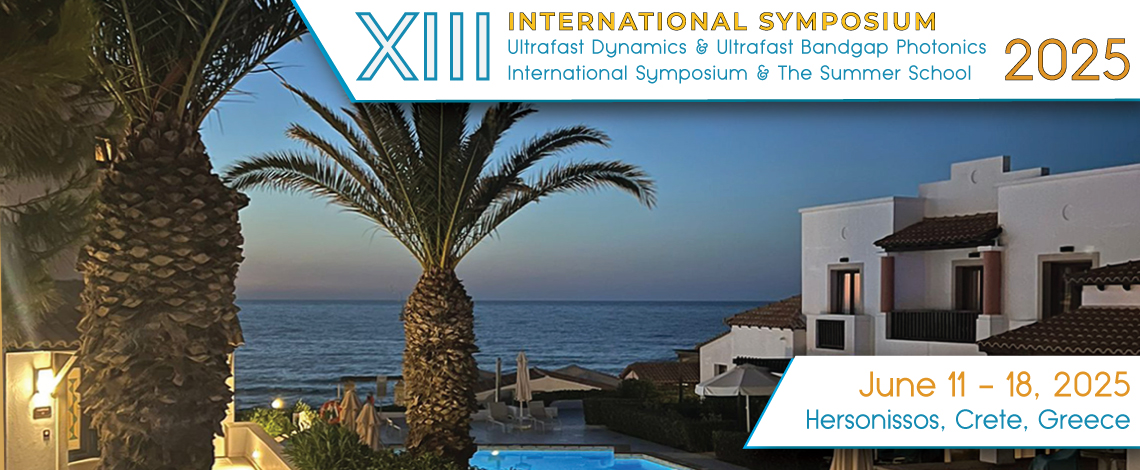Summer School on Dynamics of Nonequilibrium
Crete Summer School in Dynamics of Nonequilibrium will be held in the conjunction with XIII Symposium in Ultrafast Dynamics and Ultrafast Bandgap Photonics. The School is a week-long event that allows the attending students to become for time being a part of the research community representing World-recognized researchers actively working in the field of Ultrafast Dynamics, Metastability and Ultrafast Bandgap Photonics. Crete Symposia eventually became one of the biggest International meetings for research and academic communities working Dynamics of Nonequilibrium.
School is set up as a series of seminars run by World-class research and academic team leaders who focused at the most prospective and challenging areas in Dynamics of Nonequilibrium states.
School seminars covering all the major aspects of Dynamics of Nonequilibrium-Ultrafast Dynamics and Metastability, Ultrafast and Nonequilibrium Magnetism, Nonequilibrium High Temperature Superconductivity, Pump-Probe Experiments, Spectroscopy and Microscopy, Atto-science and Nonlinear Optics, Ultrafast Bandgap Photonics and Photovoltaics, Ultrafast Dynamics in Semiconductors, Floquet Engineering and Nonequlibrium in Topological States and Nonequilibrium Dynamics in Low Dimentionals and other exciting topics.
School allows participating students not only to learn from leading researchers in master-classes, but also to be engaged into team work with leading academic teams while presenting their own results in the team work along with leading research experts discussing their most recent exciting results.
Guest students have privilege to attend school with no fee, while special provisions were set up for meal, venue hotel property use and entertainment of the attendees as well. In order to attend the school students should register based on recommendation their academic and/or science advisers.
The Crete Summer School Seminars
Seminars last from 1.5 to 4 hours and include both some Plenary talks, some Invited talks, team presentations and master classes - with related academic background.
 |
I. Professor Rupert Huber, Universität Regensburg, Germany
"Lightwave electronics in quantum materials in real and momentum space"
|
Lightwave electronics has emerged as a vibrant research field at the interface of electronics and optics. The intriguing idea is to exploit the oscillating carrier field of intense light pulses as an ultrafast electric bias to accelerate electrons in condensed matter faster than a cycle of light. As these femto- to attosecond time scales are shorter than typical scattering times of electrons even in the dense many-body system of a solid, lightwave-driven electrons can move fully ballistically, unleashing a fascinating all-coherent quantum world. The consequences of this approach are spectacular. They include the possibility to implement new collider concepts that reveal the inner workings quasiparticles, just like particle colliders explore elementary particles. In an all-coherent regime of periodic electron acceleration, new band structures can be optically tailored by Floquet engineering, and selection rules for inter- and intraband dynamics can be defined on the fly. Remarkably, photoelectron spectroscopy has made dramatic strides to resolve such subcycle dynamics directly in band-structure movies. All these ideas could lay the foundations for a transformation in electronics:
The electronic clock of conventional CMOS technology could be replaced with the carrier wave of light to enable a speed-up of information technology by many orders of magnitude; first device functionalities have already been shown. Another ongoing revolution has been sparked by the idea to bring lightwave electronic control to atomic length scales; in lightwave-driven scanning probe microscopy it is now possible to follow the motion of the building block of matter – electrons, atoms and molecules – directly on their intrinsic ultrashort length and time scales. In this seminar we will discuss a cross section of this rapidly emerging and diversifying research field and particularly highlight how lightwave-driven electrons can be directly visualized in real and momentum space.
Seminar
Weizhe Li, Friedrich-Alexander-Universität Erlangen-Nürnberg, Germany
"Dynamical selection rules for photocurrents"
Alex Giovannone, University of California Santa Barbara, USA
"Colliding quasiparticles in semiconductors and quantum materials"
Svenja Nerreter, Universität Regensburg, Germany
"All-optical subcycle microscopy at atomic length scales"
Vincent Eggers, Universität Regensburg, Germany
"Subcycle band-structure videography of lightwave-driven graphene"
Simon Meier, Universität Regensburg , Germany
"Attosecond electron dynamics in atomic-scale lightwave-scanning tunneling microscopy"
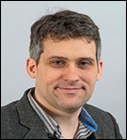 |
II. Professor Steven Johnson, ETH Zürich, Switzerland
"Ultrafast coherent dynamics: overview of coherence in atomic and spin systems”
|
Coherence is a key characteristic of many ultrafast phenomena, and can be of critical importance in potential new functionalities of materials. In this introductory talk for a seminar on experimental methods of driving and observing coherence in materials, I discuss generally what is meant by coherence in the context of atomic (ionic) dynamics [1,2] and for spin dynamics [3,4], and give some examples of different kinds of coherences that have been explored to date. I will also discuss in general terms the mechanisms for generating coherences using ultrafast methods and their connections to concepts of symmetry and ultrafast material control.
 |
Fig. 1: Conceptual sketch of different mathematical limits of driving coherence in a (semi-)classical system via a time-dependent force F(t) on an oscillator with coordinate y. The top row sketches the time-dependence of F(t), the middle row shows the corresponding Fourier transform, and the bottom row shows the resulting dynamics of <y> for an ensemble of oscillators. Left column: In the “impulsive” limit the force is zero except for a time very short compared to the oscillator period, resulting in sine-like oscillation of <y> about 0. Middle column: in the “displacive” limit the force has the form of a step function, resulting in cosine-like oscillations about a displaced new equilibrium. Right column: in the “resonant” limit the frequency of the force matches that of the natural oscillator frequency, resulting in more slowly growing oscillations in <y> about 0.
|
The remaining talks in the mini-symposium will review experimental techniques to study such coherences using THz radiation, optics and x-rays.
References
[1] H. J. Zeiger, J. Vidal, T.K. Cheng, E.P. Ippen, G. Dresselhaus, M.S. Dresselhaus,. Physical Review B 45, 768 (1992).
[2] R. Merlin, Solid State Communications 102, 207 (1997).
[3] T. Kubacka, A.J.Johnson, M.C. Hoffmann, C.Vicario, S. de Jong, P.Beaud, S. Grubel, S.-W. Huang, L. Huber, L. Patthey, Y.-D. Chuang, J. Turner
G. L. Dakovsky, W.S. Lee, M.P. Minitti, W. Schlotter, R. G. Moor, C.P. Hauri, S.M Koohpayeh, V. Scagnoli, G. Ingold, S.L.Johnson, U. Staub.
Science 343, 1333 (2014)
[4] T. Kampfrath, A SeIl, G. Klatt, A. Pashkin, S. Mährlein, T. Dekorsy, M. Wolf, M. Fiebig, A. Leitenstorfer, R.Huber.Nature Photonics 5, 31 (2011).
[5] M. Först, C. Manzoni, S. Kaiser, Y. Tomioka, Y. Tokura, R. Merlin, A. Cavalleri,. Nature Physics 7, 854 (2011).
[6] R. Mankowsky,M Först, A Cavalleri, Reports on Progress in Physics 79, 064503 (2016).
Seminar
Professor Steven Johnson, ETH Zürich, Switzerland
"Ultrafast coherent dynamics: overview of coherence in atomic and spin systems"
Urs Staub, Paul Scherrer Institut PSI, Switzerland
"X-rays to study ultrafast lattice and magnetisation dynamics"
Jure Demsar, Johannes Gutenberg Universität Mainz, Germany
"Collective mode dynamics in pressure-tuned charge-density-wave systems"
Elsa Abreu, ETH Zürich, Switzerland
"Conductivity dynamics in THz driven spin-ladders"
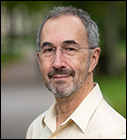 |
III. Professor Hermann Durr, Uppsala Universiteit, Sweden
"Ultrafast Magnetisation Dynamics"
|
This master class aims at highlighting important topics related to ultrafast magnetization dynamics following femtosecond optical excitation. We will discuss angular momentum transfer between spin and lattice excitations and the element specificity of spin transfer processes for various materials ranging from metals to insulators.
Seminar
Hermann Durr, Uppsala Universitet, Sweden
"Nanoscale spin-boson coupling"
Martin Aeschimann, Rheinland-Pfälzische Technische Universität Kaiserslautern-Landau, Germany
"Ultrafast magnetism across magnetic material classes"
Clemens von Korff Schmising, Max-Born-Institut für Nichtlineare Optik und Kurzzeitspektroskopie, Germany
"Interatomic spin transfer"
Peter Oppeneer, Uppsala Universitet, Sweden
"Demagnetization and magnon excitation"
Andrei Kirilyuk, Radboud Universiteit, the Netherlands
"Phonon-spin coupling"
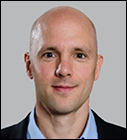 |
IV. Professor Stefan Mathias, Georg-August-Universität Göttingen, Germany
"Ultrafast photoemission spectroscopy of exciton dynamics in
2D semiconductor heterostructures"
|
Excitons – two-particle correlated electron-hole pairs – are the dominant low-energy optical excitation in the broad class of semiconductor materials, which range from classical silicon to perovskites, and from two-dimensional to organic materials. Spin and valley degrees of freedom in the semiconductor’s electronic dispersion are the source of a rich energy landscape of bright and dark excitons. However, experimental access to the full landscape is often challenging. In recent years, ultrafast angle-resolved photoelectron spectroscopy (ARPES), and in particular ultrafast momentum microscopy, has emerged as a powerful experimental tool enabling direct access to the exciton energy landscape, and, more generally, to the momentum-coordinate of the exciton wavefunction. This allows following femtosecond temporal dynamics of bright and dark excitons alike, even to the level of the quantum mechanical wavefunction. In this seminar, exemplary works on ultrafast photoelectron spectroscopy of Floquet physics and exciton dynamics in real and momentum space will be presented. Studies on graphene, two - dimensional transition metal dichalcogenides, organic semiconductors, and their hybrid heterostructures showcase the strength of this approach.
Seminar
Stefan Mathias, Georg-August-Universität Göttingen, Germany
"Ultrafast momentum microscopy for the study of exciton and Floquet physics in 2D materials"
Mirko Cinchetti, Technische Universität Dortmund, Germany
"Ultrafast modulation of proximity-enhanced functionalities in hybrid nano-scale system"
Michael Bauer, Christian-Albrechts-Universität zu Kiel, Germany
"Exciton-polariton formation and propagation in semiconducting transition metal dichalcogenides"
Jan-Philipp Bange, Georg-August-Universität Göttingen, Germany
"Dark field photoelectron momentum microscopy and electric field gated 2D semiconductors"
Sebastian Hedwig, Rheinland-Pfälzische Technische Universität Kaiserslautern-Landau, Germany
"Excited charge- and spin-carrier dynamics in WSe2"
Wiebke Bennecke, Georg-August-Universität Göttingen, Germany
"Exciton photoemission orbital tomography from 2D semiconductor materials"
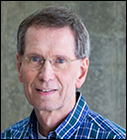 |
V. Professor Rolf Binder, University of Arizona, USA
"Non-Hermitian physics in semiconductors"
|
The aim of this Master Class Seminar is to provide an introduction to non-Hermitian effects in semiconductors and present state-of-the-art examples. Optically pumped semiconductors are open-dissipative many-particle systems where numerous physical phenomena differ from those found in systems that are in thermal equilibrium. This involves simple relaxation processes that are non-Hermitian (i.e. are described by effective Hamiltonians that are non-Hermitian and break time-reversal symmetry, TRS). Such relaxation processes are often considered uninteresting. Non-Hermitian phenomena, however, can also be quite exotic and interesting. Chief among those are phenomena related to exceptional points in the effective Hamiltonian's spectrum. This seminar is intended for graduate students with an interest in semiconductor optics. After a general introduction to semiconductors, TRS-breaking relaxation phenomena, as well as basic concepts of non-Hermitian physics at the level of a graduate course, three seminar talks will provide a deeper understanding of state-of-the-art examples of highly excited semiconductors and non-Hermitian phenomena in these systems.
Seminar
Rolf Binder, University of Arizona, USA
"Introduction to semiconductors and non-Hermitian physics"
Peter Littlewood, University of Chicago, USA
"Active quantum matter"
Denis Golez, Institut "Jožef Stefan", Slovenia
"Optical signatures of dynamical excitonic condensates"
Ryo Hanai, Kyoto University , Japan
"Photoinduced non-reciprocal phase transitions"
 |
VI. Professor Michael Rübhausen, Universität Hamburg, Germany
"Low energy excitation in HTC superconductor"
|
The aim of this master class is to elucidate the complex excitation landscape in the single-particle (quasiparticles) and two-particle (collective mode) channel of superconductors when theory meets experiment. We will further connect to important topics such as unconventional superconductivity and the interplay between charge- density wave systems and superconductivity.
Seminar
Michael Rübhausen, Universität Hamburg, Germany
"Low energy excitation in HTC superconductor"
Dirk Manske, Max-Planck-Institut für Festkörperforschung, Germany
"Recent progress on Higgs spectroscopy of superconductors"
Tomke Glier, University Colorado Boulder, USA
"Observation of Higgs modes in superconductor by non-equilibrium anti-Stokes Raman scattering"
Ken Burch, Boston College, USA
"Discovering new quasi-particles with Raman spectroscopy"
Jacob Dolgner, Max-Planck-Institut für Festkörperforschung, Germany
"Pair-breaking features of Raman spectra”
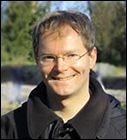 |
VII. Professor Ludwig Mathey, Universität Hamburg, Germany
"Light-induced dynamics in graphene"
|
Light induced dynamics in solids presents novel opportunities in condensed matter physics. These include significant advances of understanding of materials and their excitations, by inducing dynamics and probing well outside of the linear response regime, in a pump-probe setting. Furthermore, the driving solids via light can be used to establish genuine non-equilibrium states that are qualitatively distinct from equilibrium states. And finally, these non-equilibrium states can display novel functionalities, potentially of technological interest.
In this seminar, I give an introduction to two methods that we have designed to describe light-induced dynamics in solids. The first method is aimed at superconductors, and utilizes semiclassical dynamics of the order parameter field and the electromagnetic field, in a lattice-gauge representation. The second method is aimed at graphene dynamics, and related materials, and utilizes a master equation approach. I will describe these methods, and discuss studies performed with them. These studies include inducing time crystals and counterflow states in superconductors, Hall and linear conductivity in light-driven graphene, and light-induced gain reflectivity in both systems.
Seminar
Ludwig Mathey, Universität Hamburg, German
"Light-induced dynamics in superconductors and graphene"
Riek Rüstemeiers, Universität Hamburg, Germany
"Optical control of coherent electronic currents in patterned graphene nanoribbons"
Hector Collado, Universität Hamburg, Germany
"Coherent control of photoconductivity in graphene nanoribbons"
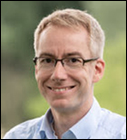 |
VIII. Professor Claus Ropers, Max-Planck-Institut für Multidisziplinäre Naturwissenschaften
"Ultrafast imaging and diffraction with electrons and photons"
|
Understanding how materials evolve under non-equilibrium conditions requires tools that can resolve ultrafast structural dynamics with high spatial and temporal precision. Recent advances in time-resolved imaging and diffraction using coherent electron beams create new possibilities to observe the fundamental processes that govern structural phase transformations, the excitation and propagation of strain waves, and the redistribution of phonon populations far from equilibrium. This mini-series provides an introduction to a complementary set of experimental techniques that provide insights into the dynamical behavior of quantum and functional materials, with an emphasis of diffractive electron probing across a range of energies. Complementing these structural probes, magnetic imaging based on coherent diffractive imaging using high-harmonic radiation combined with circular dichroism enables ultrafast, element-specific access to spin dynamics with nanoscale spatial resolution.
Seminar
Claus Ropers, Max-Planck-Institut für Multidisziplinäre Naturwissenschaften, Germany
"Ultrafast electron microscopy and diffraction"
Till Domröse,Max-Planck-Institut für Multidisziplinäre Naturwissenschaften, Germany
"Ultrafast transmission electron microscopy and diffraction"
Felix Kurtz, Max-Planck-Institut für Multidisziplinäre Naturwissenschaften,Germany
"Ultrafast low-energy electron diffraction"
Johannes Otto, Max-Planck-Institut für Multidisziplinäre Naturwissenschaften, Germany
"Ultrafast low-energy electron microscopy"
Sergey Zayko, Max-Planck-Institut für Multidisziplinäre Naturwissenschaften, Germany
"Ultrafast high harmonic microscopy (UHM) for magnetic imaging"
Please note that participation to Summer School Seminars is FREE.
Declaration of participation is needed.
Please click here for your participation.










